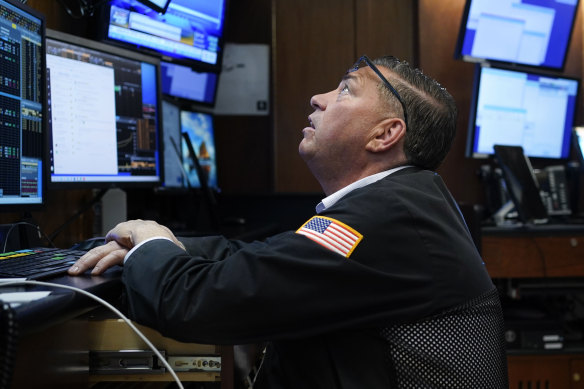ASX expected to open lower as Wall Street frets rate hikes
By Damian J Troise, Alex Veigac and Staff reporter
Australian shares are expected to open lower after a weak lead in from Wall Street as investors fret over a stubbornly high rate of inflation and prospects of further rate rises in 2023.
ASX futures were pointing to a fall of 38 points, or 0.54 per cent, to 6,953.5 at 8am this morning.
On Wall Street, stocks gave up an early gain and ended lower Tuesday, a lacklustre first trading day of 2023 for Wall Street just days after it closed the books on its worst year since 2008.

The S&P 500 shed a 1 per cent gain and finished 0.4 per cent lower. The Dow Jones Industrial Average slipped less than 0.1 per cent and the Nasdaq composite dropped 0.8 per cent. Small-company stocks also lost ground, pulling the Russell 2000 index 0.6 per cent lower.
Technology stocks were among the biggest weights on the market. Apple fell 3.7 per cent, leaving its market value below $US2 trillion for the first time since March 8, 2021. Shares in the iPhone maker fell nearly 27 per cent in 2022, their first annual decline in four years amid a broad slide in technology sector stocks.
Long-term bond yields fell significantly. The yield on the 10-year Treasury, which influences mortgage rates, fell to 3.77 per cent from 3.88 per cent late Friday. Stock and bond markets were closed Monday for the observed New Year’s Day holiday.
Investors are opening a new year with the same concerns that weighed on markets in 2022, leading the benchmark S&P 500 to plunge nearly 20 per cent for the year, just its third annual decline since the financial crisis 14 years ago.
“With the market down 20 per cent, things are on sale, 20 per cent off,” said Randy Frederick, managing director of trading & derivatives at Charles Schwab. “You’d think people would be willing to come in and buy a little bit, if they’re long-term focused. In the short term, it’s a little bit tougher.”
Inflation is easing, but remains stubbornly hot, which has prompted the Federal Reserve to keep raising interest rates to slow economic growth. That has left Wall Street bracing for the recession and higher unemployment that could result from those policies.
The Fed will release minutes from its December policy meeting on Wednesday, potentially giving investors more insight into its decision-making process and thoughts heading into 2023. The central bank’s next policy decision on interest rates is set for Feb. 1.
The Fed’s key lending rate stands at a range of 4.25 per cent to 4.5 per cent after rocketing from a range of 0 per cent to 0.25 per cent at the beginning of 2022. The U.S. central bank forecasts that it will reach a range of 5 per cent to 5.25 per cent by the end of 2023 and it currently doesn’t call for a rate cut before 2024.
Investors are also looking ahead this week to several updates on the employment market, which has been a strong area of the broader economy. That has helped buffer the economy from a recession, analysts have said, but it also makes the Fed’s fight against inflation more difficult and raises that risk that it could go too far and bring on a recession.
The government will release a report Wednesday on job openings for November, followed by a weekly report on unemployment on Thursday. The broader and closely-watched monthly report on employment, for December, will be released on Friday.
“If we get a weak report, that would be a boost to the market because it might imply that the Fed will ease back a bit on the rate hikes,” Frederick said.
Wall Street is also waiting on the latest round of corporate earnings reports, which will start flowing heavily around the middle of January. Analysts polled by FactSet expect earnings for companies in the S&P 500 to broadly slip during the fourth quarter and remain flat for the first half of 2023.
Energy stocks also weighed on the market Tuesday as U.S. oil prices settled 4.1 per cent lower. Hess fell 5.1 per cent.
Facebook parent Meta Platforms rose 3.7 per cent to lead a rally in communications services stocks. Gains in several big banks and other financial stocks also helped keep the market’s losses in check. Wells Fargo rose 1.2 per cent.
Tesla plunged 12.2 per cent for the biggest decline among S&P 500 stocks after the electric vehicle maker’s 2022 sales disappointed investors.
Gold producer Newmont rose 5 per cent, the biggest gain in the S&P 500, as prices for the precious metal rose.
All told, the S&P 500 fell 15.36 points to 3,824.14. The Dow slipped 10.88 points to 33,136.37. The Nasdaq slid 79.50 points to 10,386.98. The Russell 2000 fell 10.51 points to 1,750.73.
Markets in Europe and Asia gained ground.
With Associated Press
Most Viewed in Business
Source: Thanks smh.com